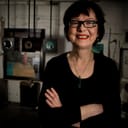Stay in the Loop
BSR publishes on a weekly schedule, with an email newsletter every Wednesday and Thursday morning. There’s no paywall, and subscribing is always free.
Measuring perfection among the imperfect
The Mütter Museum presents David Orr's 'Perfect Vessels'

By creating art exhibitions within the context of science, the Mütter Museum recognizes the link between scientists and artists. Their current exhibition, Perfect Vessels, is David Orr’s photographic study of skulls from the Mütter collection.
The word “vessels” refers to the use of human skulls as bowls in ancient cultures. “Perfect,” refers to symmetry, which the exhibition says is “a cultural signifier of perfection.” These photographs achieve symmetry through manipulation of the print, mirroring one side of the skull but presenting it as the whole.
Orr’s photographs are beautifully created in strong monochrome and presented in tondi upon a black ground. This round format emphasizes the circularity of the skulls. A few biographic words, sometimes names, identify them: an 80-year old man; lobotomized individual; young man who committed suicide.
What lies beneath
Before art school, I worked as a social worker with a neurodevelopmental pediatrician evaluating infants for medical disabilities and syndromes. During the evaluation, the doctor had a disconcerting habit of muttering, “hypertelorism” or “simian crease.”
In response to this doctor’s question, “Dysmorphic change?” his professional entourage looked at an alarmed parent, assessing whether wide-set eyes or single-creased palms were merely familial traits or something worse. Sometimes, it was no more than baby looking like parent. In worse situations, even subtle changes — easily dismissed as trivial — could mean imposing the most painful information a parent will ever receive: disabling syndrome or early death of their baby. At those times, I was the professional left in the examining room as the family watched their world collapse.
Wandering through the Mütter Museum, I think of these babies while looking at specimens of strange abnormalities. I see the plaster cast of Chang and Eng Bunker joined at the chest, the first to be identified as Siamese twins; the skeleton of the American giant; babies who never made it beyond jars because of severe deformities. Of course, I do not witness the pain these individuals and their families experienced; pain is pushed away by the pursuit of knowledge, time, and glass containers.
In art school, I was taught to see differently. A still life is seen less in terms of discernible objects but as dynamic relationships: light and shadow, near and far, together and separate. Likewise, I learned portraits were dependent not upon the visible, but upon the muscles and bones that lie beneath.
Whose perfection?
Despite their perfect symmetry, there is much wear and tear in Orr’s skulls, and I think of Sam, my son’s friend, who accidentally shot his eye out with a potato gun when he was 12 years old. Morbidly, I imagine Sam’s skull with a beautifully reconstructed platinum socket for a never-again-sighted eye and wonder, if Sam blows out his other eye, is that symmetry closer to perfection?
The artist’s decision to create perfect symmetrical skulls in a museum that screams of distortions is interesting, but perhaps that’s the point. Both medicine and the photographs appeal to an ideal. This creation of a stable reference point from which anything can be judged, in turn, structures a world where definitive answers are possible.
Art too has it ideals, but it also shows a way of experiencing the particular. When I draw an apple, I am drawing that apple at that time in that place, creating a world of ever-changing specifics that undermine absolutes.
It is not surprising that emphasis in education is placed upon science and math over the lesser certainties of the arts. We depend upon medicine for survival, and our culture is often wary of ambiguity. After all, who wants the doctor answering, “I don’t know?”
Art and ambiguity
But even with exhibitions such as Perfect Vessels demonstrating the links between art and science, art gets pushed aside and depicted as non-essential by comparison to science. And yet, art is one way we can navigate ambiguity and gain a better an understanding of our lives.
I am left alone with the devastated family in the neurodevelopmental examining room. The strange doctor knows their why question can’t be answered with explanations of chromosomes and chemistry; their questions of what will happen can only be answered with time.
In this room, ideals are shadows. Since their baby is not a perfect vessel, they are left only with ambiguity, which our culture has not helped them experience as an alternative to the ideal.
But the family will learn to survive, becoming as artists recreating a world not from value judgments based upon ideals but from their very real, non-conceptualized experience with that baby for whom there is no comparison.
What, When, Where
Perfect Vessels. Through Jan. 5, 2017 at the The Mütter Museum, 19 W. 22nd St., Philadelphia. (215) 560-8654 or muttermuseum.org.
Sign up for our newsletter
All of the week's new articles, all in one place. Sign up for the free weekly BSR newsletters, and don't miss a conversation.

 Treacy Ziegler
Treacy Ziegler